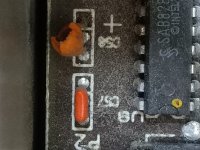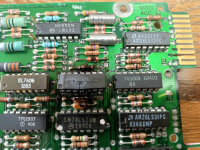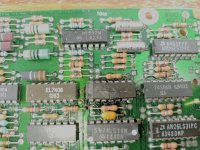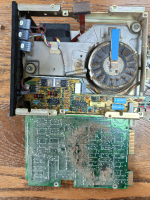Hi, I'm relatively new to electronics and vintage computer repairs and soldering.
But I want to try to get into such repairs.
I currently bought an old IBM XT 5160 with an IBM 5153 CGA monitor.
In the beginning they didn't work, but the PSU ventilator spinned up and eventually the Tandon 100 tape drive LED flickered for a moment. The CGA gave a grey light image only.
Then, I don't remember exactly the circumstances, A capacitor near the P8 P9 PSU connectors exploded with an orange flame and some smoke and smells.
That was the moment the hard disk began to spin up and the monitor gave a black screen.
I was a bit shocked and while the hard disk began smoking a lot I was still not able to react instantly. So I eventually shut down the power a little to late.
On the PCB I found an IC cracked and burned up. I'm not sure if it's the culprit of a diode near by or if maybe the dust on the PCB became conductive.
I'm now wondering if I may be able to fix that PCB and if the drive then might present it's data again?
Unfortunately the IC is no longer exactly identifiable. But it seems to be a Fairchild Semiconductor beginning with DM and ending to N.
I looked up with Google image search to find that PCB and identify it that way.
It seems to be a DM74574N, but I can't find such an IC. In the handwritten schematic in the service manual if the drive I also read it as DM74574N, also on other images of that PCB.
But then I found a different one with another font used in the imprint. It was a SN74S74N. Therefore I guess now, that it was probably a S instead of a 5. So a DM74S74N instead of DM74574N. It took me a long time to get to that point.
I'm still not sure, therefore I decided to ask in this forum for help.
Two different PCBs from the manual.
Unfortunately mine is a little bit different. It looks like the PCB from the 'higher intellect ' webpage.
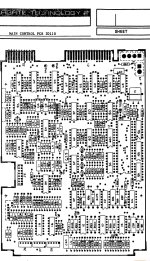
C14 or 6K
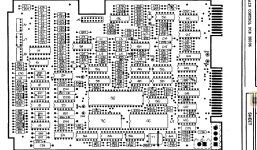
On eBay someone sells the Chip with a clear and decent foto. So it looks more like an S then in the Fotos of the PCB.
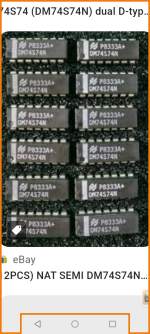
The Texas instruments SN74S74N. With this font it looks more like a S instead of a 5.
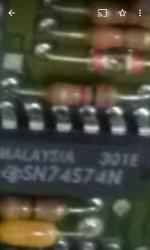
A PCB with the Fairchild one. The S looks more like a 5 to me.
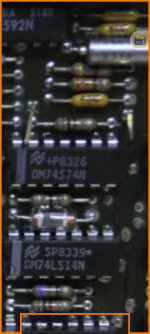
The image of the PCB on the higher intellect webpage that made me think it's the DM74574N instead of the DM74S74N

But I want to try to get into such repairs.
I currently bought an old IBM XT 5160 with an IBM 5153 CGA monitor.
In the beginning they didn't work, but the PSU ventilator spinned up and eventually the Tandon 100 tape drive LED flickered for a moment. The CGA gave a grey light image only.
Then, I don't remember exactly the circumstances, A capacitor near the P8 P9 PSU connectors exploded with an orange flame and some smoke and smells.
That was the moment the hard disk began to spin up and the monitor gave a black screen.
I was a bit shocked and while the hard disk began smoking a lot I was still not able to react instantly. So I eventually shut down the power a little to late.
On the PCB I found an IC cracked and burned up. I'm not sure if it's the culprit of a diode near by or if maybe the dust on the PCB became conductive.
I'm now wondering if I may be able to fix that PCB and if the drive then might present it's data again?
Unfortunately the IC is no longer exactly identifiable. But it seems to be a Fairchild Semiconductor beginning with DM and ending to N.
I looked up with Google image search to find that PCB and identify it that way.
It seems to be a DM74574N, but I can't find such an IC. In the handwritten schematic in the service manual if the drive I also read it as DM74574N, also on other images of that PCB.
But then I found a different one with another font used in the imprint. It was a SN74S74N. Therefore I guess now, that it was probably a S instead of a 5. So a DM74S74N instead of DM74574N. It took me a long time to get to that point.
I'm still not sure, therefore I decided to ask in this forum for help.
Two different PCBs from the manual.
Unfortunately mine is a little bit different. It looks like the PCB from the 'higher intellect ' webpage.

C14 or 6K

On eBay someone sells the Chip with a clear and decent foto. So it looks more like an S then in the Fotos of the PCB.

The Texas instruments SN74S74N. With this font it looks more like a S instead of a 5.

A PCB with the Fairchild one. The S looks more like a 5 to me.

The image of the PCB on the higher intellect webpage that made me think it's the DM74574N instead of the DM74S74N

Last edited:

